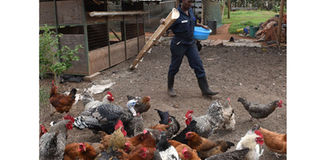Here is how to boost your poultry egg production

Your hens will give more eggs if you feed them correct Photo | Ismael Keezala
What you need to know:
- The hen will often sit on the clutch of eggs for 21 days. This to a farmer who is out to sell eggs, could only mean that his business will suffer the loss of egg production from one of his hens.
Poultry farming is steadily and surely gaining ground. A new wave of health-conscious consumers seeking indigenous (local) poultry products has also risen. This is a major driver of the current shift by farmers to chicken farming.
However, chicken farming can be quite tricky. There are several challenges that poultry farmers face; such as disease outbreaks, low egg production, and predators, among others.
However, in some instances a farmer aiming at increasing his flock’s egg production is disappointed when the hen’s natural instinct kicks in and it decides it is time to stop laying eggs and desire to sit on its eggs until they hatch. A term commonly referred to as broodiness.
However, this is something that may not occur in some commercial chicken breeds as the broodiness trait has been selected against.
Broodiness is an instinctive behaviour exhibited in laying hens, often triggering a decline in egg production. The laying hen desires to sit on her eggs and thus her main focus is not on egg production but on preparing for incubation and finally hatching chicks.
The hen will often sit on the clutch of eggs for 21 days. This to a farmer who is out to sell eggs, could only mean that his business will suffer the loss of egg production from one of his hens. Typically a hen will begin to lay eggs at 18-22 weeks of age and the egg production will peak about six to eight weeks later.
Drastic change
A drastic change in this expected peak or the continuity of laying eggs would be a scenario that many a farmer would prefer to discourage so as to get the most out of their chicken, unless they are interested in hatching chicks. It has been documented that broodiness is ‘contagious,’ in that one broody hen can set off behavioural changes in the rest of the flock. Indeed this would be a great ‘catastrophy’ to any farmer.
The greatest challenge for a farmer would be to control a condition that is innate and genetics-controlled. There are, however, some quick-fix solutions that have been used, some drawing from the indigenous knowledge that our grandparents have depended on over time.
Prevent broodiness
It has been encouraged that the best way to handle broodiness is to prevent it as opposed to trying to break it.
Preventive measures may include — changing the laying boxes environment, since hens often prefer to have their laying boxes in dark, draught free and warm areas, removal of one of these elements could discourage hens from getting broody.
For example increase of lighting discourages broodiness, as well as moving of the nesting boxes to areas that are more exposed. However, the downside of this would be affecting egg production in the other birds.
Most hens are often affected by sudden changes in their usual patterns. The change of the position of nesting boxes often throws the laying hens off-balance and could result to reduced egg production.
Another common practice that could prevent broodiness is frequent collection of eggs from the laying boxes, accumulation of eggs in the nest boxes may trigger off broodiness.
Disturbance of birds
Accurate designing of the chicken coop, whereby one ensures that entrance doors do not form or create corners that can be used as laying areas is also important.
Movement of the hen from their usual living environment to other quarters may also prevent broodiness. In addition, constant disturbances of birds from their nesting boxes has been observed as a possible preventive measure.
However, if the hen is already broody, one common practice is its placement in a wire cage with adequate food and water, often the bare wire mesh and lack of comfort or dark warm corners to brood in, could break broodiness. The main objective in using the wire cage is to make the living conditions unfavourable for the broody hen.
There have been instances where farmers have dipped the broody hen in cold water but this is a practice often discouraged. As farmers, we must always adhere to rearing animals with the five key freedoms; freedom from hunger and thirst, freedom from fear, freedom from discomfort, freedom from pain and freedom to engage in normal animal behaviour.
Sometimes farmers may need to encourage broodiness to raise the number of their poultry. For small-holder farmers who are keen on having a broody hen, it’s important to select good breeds that are natural mothers such as the short-legged chicken.
However, there are instances where the broody behaviour doesn’t kick in. So they can be encouraged to become broody. Most farmers report the use of “dummy eggs” in the nesting boxes. This approach also gives the farmer ample time to collect enough eggs to provide to the broody hen.
It is recommended that a maximum of 14 eggs can be brooded in one nest with excellent hatchability. Another approach would be to provide a safe, dark and draught-free place to sit on the eggs.
Often this can be done by hanging pieces of clothing or sack material to mimic these conditions. The provision of warm nesting environment could trigger broodiness.




